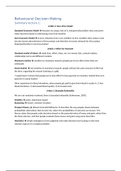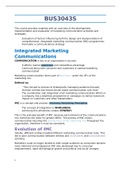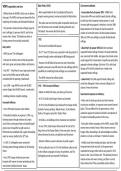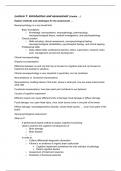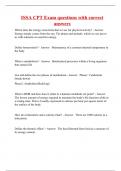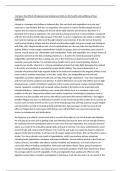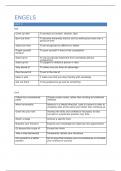Summary lecture 1:
Article 2: Zero-Price Model
Standard Economic Model Assumes no unique role of 0, and generally predicts that consumers
make decisions based on subtracting costs from benefits.
Zero Economic Model A price reduction from cost condition to free condition does reduce costs
but also boosts attractiveness of free product and therefore increases demand for this product
disproportionally to non-free product
Article 1: Effort for Payment
Standard model of labour trade time, effort, ideas, etc. for money. But, context matters;
relationship norms and different markets.
Monetary market sensitive to monetary rewards; people put in less effort when they are
underpaid.
Social market not sensitive to monetary rewards; people will put the same amount of effort all
the time, regarding the reward (nothing or a gift).
!! experiment 2 shows that people put in less effort for low-payment in monetary market than zero
payment in social market.
Other experiment in blood donations; when people get paid to give their blood it results in: 1) less
blood donations. 2) decreased blood quality. 3) increased costs.
Article 3: Bounded Rationality
We are not randomly irrational, there is bounded rationality (Kahneman, 2003).
Intuition quick, impression-based
Reasoning slower, monitors intuition
Prospect theory oftewel Vooruitzichttheorie describes the way people choose between
probabilistic alternatives that involve risk, where the probabilities of outcomes are known. The
theory states that people make decisions based on the potential value of losses and gains rather than
the final outcome, and that people evaluate these losses and gains using some heuristics.
Heuristics simple strategies to form judgment and make decisions by focusing on the most
relevant aspects of a complex problem.
,Summary lecture 2:
Not true that we are ‘superman’ making similar decisions all the time. We’re all irrational,
inconsistent and impatient in a predictable and systematic way.
TOPIC: PROSPECT THEORY & INTERTEMPORAL CHOICE.
Question 1 = answer B
Question 2 = answer A
Question 3 = answer B
Expected utility theory People maximize utility.
In a gamble where people have to choose their preference:
A. 60% chance of winning €100, 40% chance of €0
B. 100% chance of winning €50, 0% change of €0.
People rather choose B because they want to avoid risk (risk aversion). However the Probability
value shows that option A is more profitable:
A. 0,6 * 100 + 0,4 * 0 = €60,00
B. 1,0 * 50 + 0 * 0 = €50,00 Know the Probability formula!
The expected utility theory would say people rather go for option B, but …
Expected utility theory is a normative theory = how people would react in certain circumstances.
Behavioural inconsistencies actual behaviour differs from the expected utility theory. Systematic
violation of requirements of consistency and coherence. Depends on perception of decision
problems and evaluation of options. Descriptive theory; trying to explain human behaviour that is not
in line with theory.
1. Prospects of future outcome, not necessarily maximizing utility.
Article: The Framing of Decisions and the Psychology of Choice.
The subjective value of a loss falls quicker than a
gain. Thus, the emotional feelings by a loss
affects the person harder.
Prospect theory = how do people value future
outcomes or ‘prospects’?
Unlike expected utility theory: preferences
depend on how a problem is framed.
< Know the hypothetical value function
> Reference points
1. Really matters what the reference point is: depends on where you are – how you interpret loss
versus a gain.
1. If you get a speeding ticket (boete)- feels like a loss
2. If you just won a million bucks, then get a speeding ticket, that might not feel like a loss
but more like a ‘non-gain’.
2. If you experience something as a loss, you feel it much more than a gain
3. Biggest valuation changes occur near the reference point.
, Diminished returns: Value curve becomes
steeper when approaching the reference
point.
Gain €500, value = 60
Lose €500, value = 120
By gain the curve flats: in the end the value
of earning €100 will be similar to a gain of
€1000. Curve of loss is more steeply;
asymmetry, loss aversion.
F.e. 1 cupcake makes you happy, 2
cupcakes somewhat more, but 3 cupcakes
its getting less exciting.
2. Implications of Prospect Theory.
1a. Framing Effect
If you were superman, you would choose the utility option (B) but we choose A; a sure gain.
Risk aversion is terms of gains & Risk seeking in terms of losses. In case of the unusual disease
outbreak, in a gain it is a risk aversion; in the domain of losses it is risk seeking. Marketeers use the
framing ‘losses’ as it has more emotional attachment. F.e. if they state; you can install this eco-
friendly sustainable thing in your house which saves you €100,00 (gain), often they say, otherwise
you will lose €100,00 (loss). People are now more likely to but the eco-friendly thing. Framing it
differently can change decision-making.
Changing reference point:
1) Normally €10, only €9 if you pay by cash. feels like a gain
2) Normally €9, but €10 if you pay by card. feels like a loss
Gain framing assist, healthy, support instead of reduce harm, unhealthy
A 2 year guarantee removes risks.
1b. Loss Aversion
> Changes relative to a neutral reference point
> Disadvantages are more salient that equivalent advantages.
Application: #FOMO; fear of missing out. Black Friday: ‘If I don’t buy it now, I will miss a super good
deal’. Marketeers act on your loss aversion.
Application: Insurance; reducing worry, not reducing risk.

